This article appears in the January 2020 issue of Potato Grower.
Across North America, seed certification specialists are hard at work year-round to help ensure a clean, safe supply of high-quality seed for the potato industry. From coast to coast—and beyond, in some cases—their work pays major dividends for the entire potato supply chain. Following are reports from several key certification programs.
California
Alexander B. Mkandawire
Potato Seed Certification Manager
California Crop Improvement Association

Seed potato field in central California’s San Joaquin Valley
Certified seed potatoes in California are produced mainly in two areas: the Panama and Arvin areas about 450 feet above sea level in the Central Valley; and on McDonald Island and the Terminous area of the Delta region of the San Joaquin Valley, about 26 feet above sea level. Seed potatoes are produced annually in the Tulelake area close to the northern border with Oregon at about 4,000 feet above sea level, but these acres are inspected and certified by the Oregon Seed Certification Service under mutual agreement between the two states’ agencies. This year there was field production in the Westmorland area of the Imperial Valley about 30 miles north of the Mexican border at about 164 feet below sea level, and greenhouse production nearby in Holtville.
Greenhouse planting in Holtville was done in November 2019, with inspections performed in January 2020. Field planting started on January 2, 2020, in the Central Valley and on April 13 in the San Joaquin Valley. The Central Valley crop is sometimes hit by frost, but it was spared this year.
There were no significant rainfall events during the production season, so fields were fully irrigated as usual. The Mediterranean weather conditions (no rainfall and low humidity during the summer) that prevailed across the state were not conducive for disease development leading to production of high-quality crops.
California issued a statewide stay-at-home order on March 20 in which the governor exempted agricultural workers. Field inspections started at the height of the COVID-19 pandemic on April 2 in the Central Valley, on May 13 in the Imperial Valley, and on June 1 in the San Joaquin Valley. Only one seed lot was downgraded in the Central Valley due to mosaic presence. The last field inspections were completed in the San Joaquin Valley on October 8 under ashy, smoke-filled skies due to the many wildfires California experienced this year. The California potato certified seed directory can be found at ccia.ucdavis.edu/application-information/certified-potato-directory.
California’s total production of commercial potatoes was about 40,000 acres in 2020. In 2020 California saw a reduction from its five-year average of 891 acres of certified seed potatoes to 770 acres. On these acres there were a total of 47 varieties in the certification program. Apart from a proprietary variety, the varieties with the most acres were Sifra, Granola, Red La Soda, Belmonda, Soprano, Red La Soda NY10 and CalWhite.
Colorado
Andrew Houser
Manager
Colorado Potato Certification Service
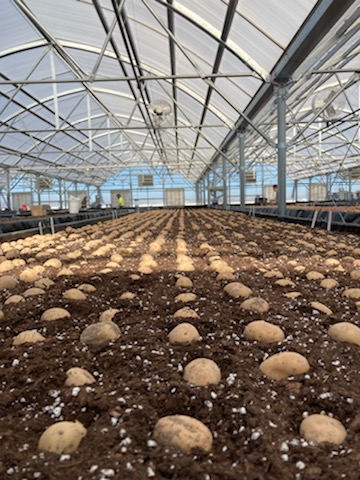
Seed potatoes being planted in a greenhouse for the Colorado 2020 post-harvest test. Photo by Sarah Noller
The growing season in Colorado was a roller coaster this year. Planting went well with warm weather and little to no rain or snow. However, seed producers were hit with two frosts, one June 10 and the other July 1. Other than the two frost events, Colorado enjoyed had a good summer with warm days and cool nights, making it ideal for potato production.
Then, on Sept. 9, just as harvest was getting underway, seed growers woke up to 12 inches of snow on the ground. This kept everyone out of the field for a while, but things warmed up and the snow melted in just a couple of days.
In a typical year, Colorado’s post-harvest test would take place on the North Shore of Oahu, Hawaii. However, due to COVID-19 and other factors, the 2020 post-harvest test will mostly take place in a local greenhouse.
The 2020 accepted certified acreage for sale after summer field inspections was 6,537 acres, up from 6,180 acres in 2019. PVY is still the biggest disease challenge Colorado seed growers face. Total potato acreage (both seed and commercial) in the San Luis Valley was 50,923 acres, up from 48,573 acres in 2019.
The 2020 top five certified seed potato varieties in Colorado are:
-
Russet Norkotah selections: 2,080 acres
-
Canela Russet: 817 acres
-
Teton Russet: 312 acres
-
Reveille Russet: 288 acres
-
Centennial Russet: 228 acres
An official 2020 certified seed directory is available online at potatoes.colostate.edu. Additional information on Colorado’s Certified Seed can be found at www.coloradocertifiedpotatogrowers.com.
All seed lots imported into Colorado are required to undergo a post-harvest test, a lab test for PVYN, and a lab test for late blight to comply with the late blight quarantine for seed coming into the San Luis Valley.
Idaho
Alan Westra
Southeast Area Manager
Idaho Crop Improvement Association
The 2020 growing season in Idaho was relatively uneventful—a welcome change from the events of 2019.
The season began with good weather, and planting was completed without serious interruption. Good growing conditions continued throughout the season and into harvest. As this article is being written, many Idaho seed growers have already completed harvest. Yields are reported as good, and seed quality going into storage is reported as good to excellent. The 2020 crop appears to have a very nice size profile.
Seed health is also good this year. During summer inspections, the number of seed lots with visually detectable levels of PVY was the lowest it has been in 10 years. Additionally, there were no detections of bacterial ring rot during field inspections.
At the conclusion of the second round of field inspections, a total of 30,068 acres are eligible for final certification this year. This is essentially unchanged from 2019. Excluding proprietary genetics, the 2020 acreage accepted for certification represents a total of 144 varieties, selections and advanced clones.
For 2020, the top varieties were:
-
Russet Burbank (35 percent of total acreage accepted)
-
Russet Norkotah (all strains, 19 percent of total)
-
Ranger Russet (11 percent)
-
Clearwater Russet (5 percent)
-
Alturas (4 percent)
-
Umatilla Russet (2 percent)
Russet Burbank acreage was down approximately 11 percent from last year, while Russet Norkotah and Alturas acreage increased 7 and 18 percent, respectively. A complete listing of this year’s seed potato crop is available in the 2019 Idaho Certified Seed Potato Directory, posted on the Idaho Crop Improvement, Inc. website at www.idahocrop.com.
Maine
Eric Hitchcock
Seed Certification Program Manager
Maine Department of Agriculture, Conservation & Forestry
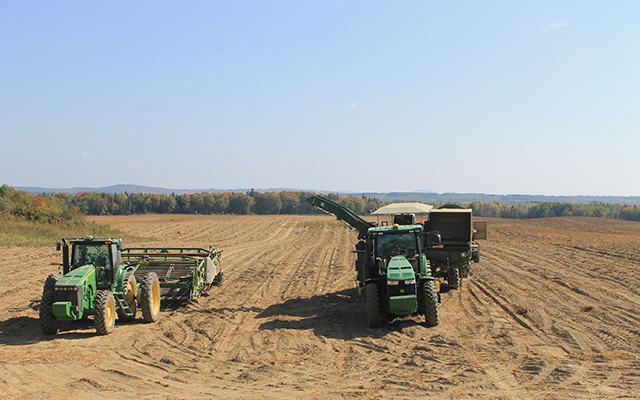
Seed potato harvest in Aroostook County, Maine. Courtesy Bangor Daily News
The 2020 growing season in Maine was somewhat challenging, with prolonged dry spells and drought conditions for the rest of the growing season in Aroostook County, at the northern tip of the state. Southern and central Maine experienced similar dry periods. Due to these conditions, many growers experienced significant yield reductions from 2019 levels.
Overall, the 2020 crop appears to be healthy, with low virus detected and low disease levels. As of Sept. 11, 2020, the certification program has 9,393 acres field certified from 91 farms.
The top 5 varieties by acreage field-certified for 2020 are:
-
Caribou Russet (PVP): 1,106 acres
-
Atlantic: 833 acres
-
3) Lamoka (PVP): 713 acres
-
4) Snowden: 688 acres
-
5) Russet Burbank (MT strain): 635 acres
Inspectors are now performing PCN soil sampling and are in preparation for laboratory PVY post-harvest testing. All samples will be ELISA post-harvest tested at the certification laboratory in Presque Isle, Maine.
Minnesota
Eric Byre
Plant Protection Program Supervisor
Minnesota Department of Agriculture
Seed potato growers in Minnesota applied to certify 6,267.41 acres for the 2020 crop year, an increase from the 6,134 acres in 2019. There were 1,123.53 acres rejected for severe mosaic and not meeting eligibility, resulting in 5,143.88 certified acres. Russet Burbank was the variety with the most acres planted.
The spring brought good weather and nearly ideal planting conditions throughout the state. Most growers were able to get in the field in late April to early May, with most completing planting by early June. In the Red River Valley, excessive rainfall in the middle of June affected some seed acres. This resulted in some drown-out. Other areas of the state experienced moderate rainfall, and as the summer progressed, growers were optimistic about the anticipated harvest. Minnesota Department of Agriculture (MDA) inspectors were busy, with three inspections conducted on all certified seed potato lots.
July was warm with ideal growing conditions, followed by a dry August and September. The heat during this period affected some quality and yields. The dry conditions continued into harvest, but some much-needed rain proved beneficial to most producers. Overall, growers reported the harvest produced average yields statewide with good quality.
The MDA Potato Inspection Unit uses a generation system and remains vigilant in detecting potato virus and other disease. The Certified Seed Potato Program continues to honor the USDA Animal and Plant Health Inspection Service memorandum of understanding for Necrotic Virus Management Plan. The global pandemic has affected the farming community in Minnesota, prompting agriculture commissioner Thom Petersen to provide guidance for each farm to implement a COVID-19 plan providing safety measures for growers and all who work in the industry.
Due to the COVID-19 global pandemic, the post-harvest winter test will be conducted in Florida this year, rather than in Hawaii. The MDA Potato Inspection Unit, along with Minnesota seed potato growers, would like to thank Ken Bertsch, Kent Sather and the North Dakota State Seed Department for helping Minnesota to align with Alger Farms in Homestead, Fla. Samples were collected in October at the office in East Grand Forks, Minn., while observing social distancing and COVID-19 guidelines. The samples will be planted and each lot observed visually for stand, vigor and potato virus. All positive potato virus visual observations are confirmed with a laboratory test. Once complete, the results will be communicated to the growers and industry.
For copies of the Minnesota Certified Seed Potato Directory, visit the Minnesota Department of Agriculture website or call (218) 773-4956.
Montana
Nina Zidack
Director
Montana Seed Potato Certification Program
Montana seed potato growers report above average yields and quality for 2020, with 95 percent of the crop in the cellars by Oct. 10, with most farms finishing in record time. One hundred percent of the crop was harvested without frost exposure, and the overall quality is excellent. The 2020 growing season was very mild throughout Montana. Potatoes were planted without significant rain delays in the spring and got off to a good start with nice June weather and reached row closure before any hot weather. Most growers had initiated vine kill by Sept. 1 and were aided by a frost on Sept. 7, which finished off most of the vines. September and the first half of October were warmer than average, but temperatures were never too high, and excessive pulp temperatures were not an issue.
Montana seed potato acreage increased significantly from 10,440 acres in 2019 to 10,878 acres in 2020. Russet Burbank is still the dominant variety, accounting for 3,852 acres—35 percent of the state’s acreage. Umatilla Russet is the second-most widely produced variety in Montana and increased from 1,376 acres in 2019 to 1,496 acres in 2020, for a total of 14 percent of Montana’s acreage. Ranger Russet acreage is steady at 1,299 acres. Clearwater acreage had been on a steady rise since its introduction to Montana in 2009, but has plateaued at 1,886 acres and is in fourth place in terms of total acreage. Alturas acreage was up slightly from 623 acres in 2019 to 652 acres in 2020. Russet Norkotah selections were up from 1,116 acres in 2019 to 1,210 acres in 2020. Standard Norkotah acreage remains very low and now accounts for only 39 acres in Montana.
Norland and Dark Red Norland are the most widely grown colored varieties in Montana, but acreage was down from 110 acres combined in 2019 to 88 acres in 2020. Chip varieties including Atlantic, Snowden and Lamoka represent a small portion of Montana’s acreage at 123 acres total, is up from 99 acres in 2019. There are a total of 55 varieties of potatoes registered for certification.
Montana canceled its 2020 Seed Potato Seminar for the first time in the history of the program. We look forward to seeing you all next year in Missoula on Nov. 10-11 at the Holiday Inn Downtown in Missoula, Mont.
Nebraska
Adam Winchester
Manager
Potato Certification Association of Nebraska
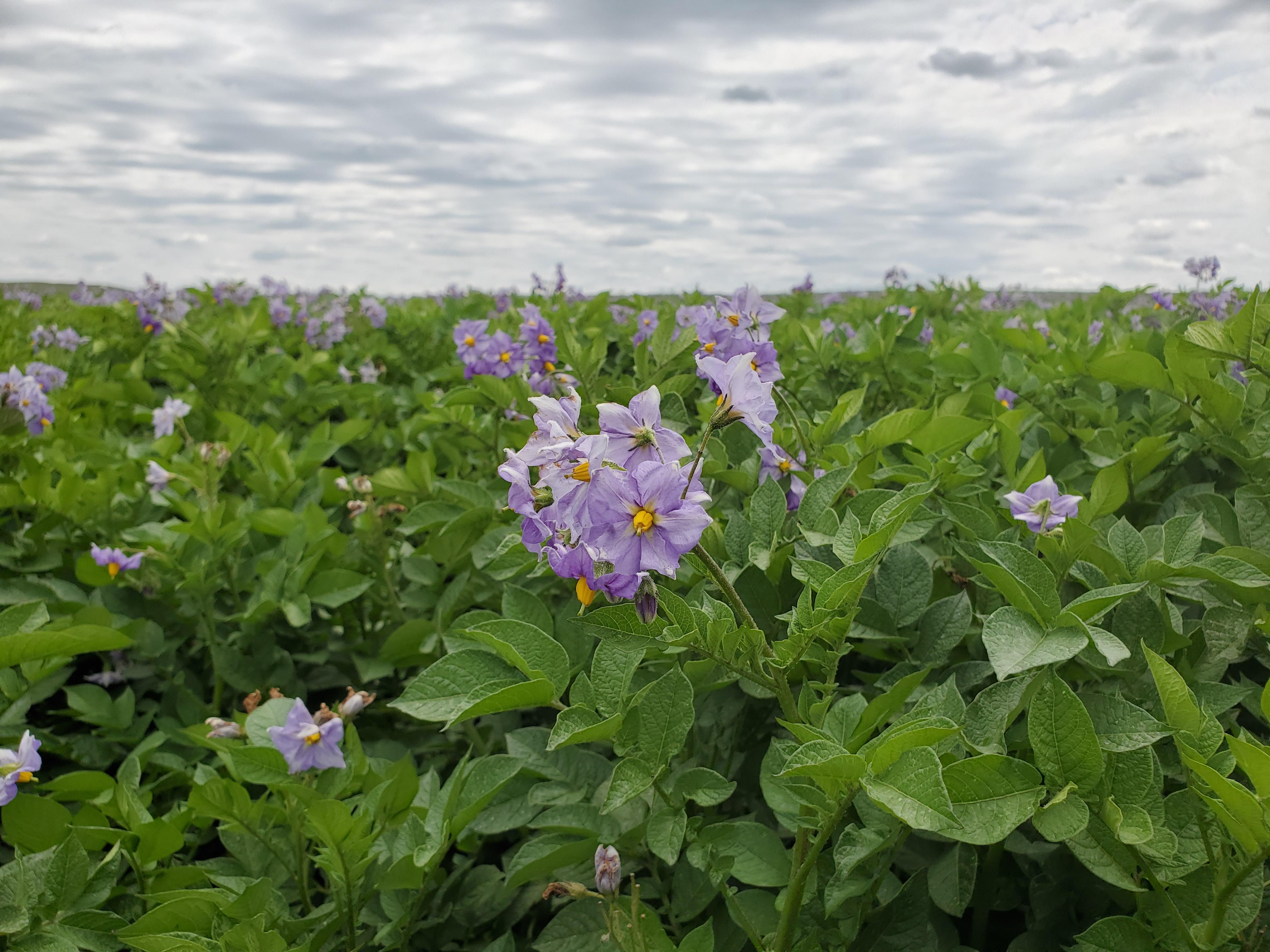
Certified seed potatoes growing in a Nebraska field.
It was a fantastic growing season for Nebraska seed potatoes. Growers reported above-average yields with high quality. Harvest went smoothly, and there were no serious loses from early frosts. The annual hailstorms did arrive in mid-August but had little to no effect on yield or quality.
In Nebraska, 7,214.87 acres were entered for certification, with 7,149.57 acres eligible for final certification. Compared to 2019, there was a slight decrease in detectable PVY during summer field inspections, though there was a slight increase in varietal mix. Summer virus tests did not report any findings for PVY.
For the 2020 season, the top five varieties grown in Nebraska were:
-
Russet Norkotah (all strains): 1089.48 acres (15 percent of total acreage)
-
Umatilla Russet: 422.56 acres (5.8 percent)
-
Russet Burbank: 420.99 acres (5.8 percent)
-
Lamoka: 416.13 acres (5.7 percent)
-
Atlantic: 157.63 acres (2.2 percent)
Field year nomenclature is now being used for all seed grown in Nebraska. For example, seed grown as generation nuclear in previous years is now designated as Field Year 1 (FY0). Nebraska is following the lead of other states in standardizing this system.
The 2020 Nebraska post-harvest test is being conducted in Homestead, Fla.; planting began the first week of November.
North Dakota
Kent Sather
Director, Potato Programs
North Dakota State Seed Department
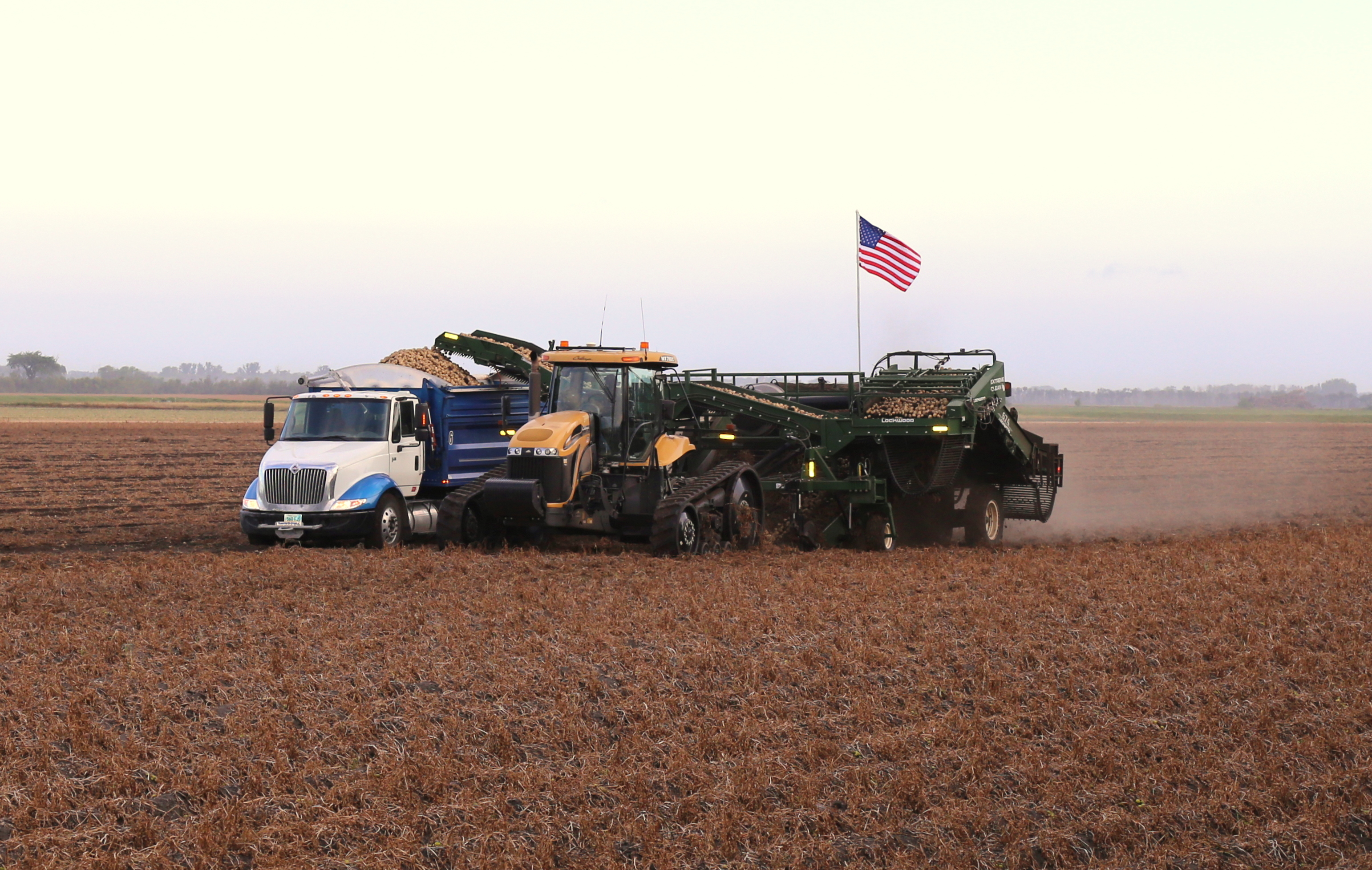
Harvest at Nilson Farms near Hoople, N.D. Photo courtesy Bette Nilson
Production of the 2020 crop of North Dakota certified seed was almost normal. It was planted and harvested on schedule. Early rains drowned minimal acreage, but got the crop off to a good start. Lack of moisture and extended warm to hot temperatures during tuber bulking reduced quality and quantity of harvested produce. On dryland acres, soil moisture was severely lacking for an ideal harvest.
Twenty-seven North Dakota certified seed growers entered acreage this year. There were 14,546 acres of seed that passed summer inspections and testing, 1,509 acres more than 2019.
The top five varieties were
-
Norland strains: 2,435 acres
-
Umatilla Russet: 2,289 acres
-
Bannock Russet: 1,431 acres
-
Dakota Pearl: 1,238 acres
-
Ranger Russet: 1,090 acres
Seed lot leaf samples as required or requested were tested for PVY and PVX. Results matched field inspection notes. Mosaic levels observed were zero or very low, with seven lots being rejected. Inspectors continued to look for Dickeya dianthicola symptoms. Suspect plants were lab-tested. As of this writing, no positives have been confirmed. Additional tuber screening for Dickeya will be done at the request of individual growers.
Phytophthora infestans was a minimal threat in 2020. Even so, growers were encouraged to use proactive fungicide applications. No late blight was found during inspections in certified seed lots. Growers were also attentive to aphid counts and were encouraged to use protective oils and insecticides, as well as to vine kill as early as possible.
Early-generation seed lots planted in isolation inspected free from viruses. These seed lots provide the basis for future North Dakota seed production. North Dakota State Seed Department seed stock staff harvested an excellent mini-tuber crop in June and October, providing a clean seed source for future crops of certified seed.
North Dakota Seed Directories can be obtained by calling the North Dakota State Seed Department at (701) 231-5000 or at our recently remodeled website at www.nd.gov/seed.
Oregon
Jeff McMorran
Certification Specialist
Oregon Seed Certification Service
Oregon certified 2,977 acres of potato seed in 2020, slightly higher than the 10-year average of 2,700 acres. Planting and early growing conditions were near ideal this year, but very hot temperatures and high winds in some areas in late August and early September may have reduced yields somewhat, especially where any water-related problems arose. Harvest conditions are near ideal in most areas, with little to report other than an occasional case of pink rot, soft rot or scab. Sizing profiles are falling on the smaller side for the most part. No lots entered for certification this year were rejected by the Oregon Seed Certification Service (OSCS), though several lots were withdrawn by the growers for poor stands or nematode finds at harvest.
Ciklamen, a red skin/white flesh variety sold into the fresh market, was the No. 1 variety produced for seed in Oregon this year at 269 acres. Clearwater Russet, Lamoka, and Gala, as well as several Frito-Lay varieties, were also near the top of the listings. A complete listing of the varieties and acres produced in Oregon, as well as more details on the field readings, can be found at seedcert.oregonstate.edu/potatoes under “Seed Report and Directory of Growers” and “Oregon Certified Seed Potato Field Readings and Statistics.”
Oregon is now following the national trend by aborting the “generation” terminology (i.e., G1, G2, G3, etc.) and adopting the “field year” terminology (FY1, FY2, FY3, etc.). The current terminology used by all U.S. states and Canada can be found on the “PAA Limited Generation Terminology Table” at seedcert.oregonstate.edu/potato-certification-national-level.
Another important change in 2020 is that winter grow-out readings will be used solely as a basis for determining a seed lot’s eligibility for re-certification, and no longer for downgrading lots. More information on OSCS Standards and policies can be found on the website noted above.
Washington
Benita Matheson
Plant Services Program Supervisor
Washington State Dept. of Agriculture
Plant Protection Division
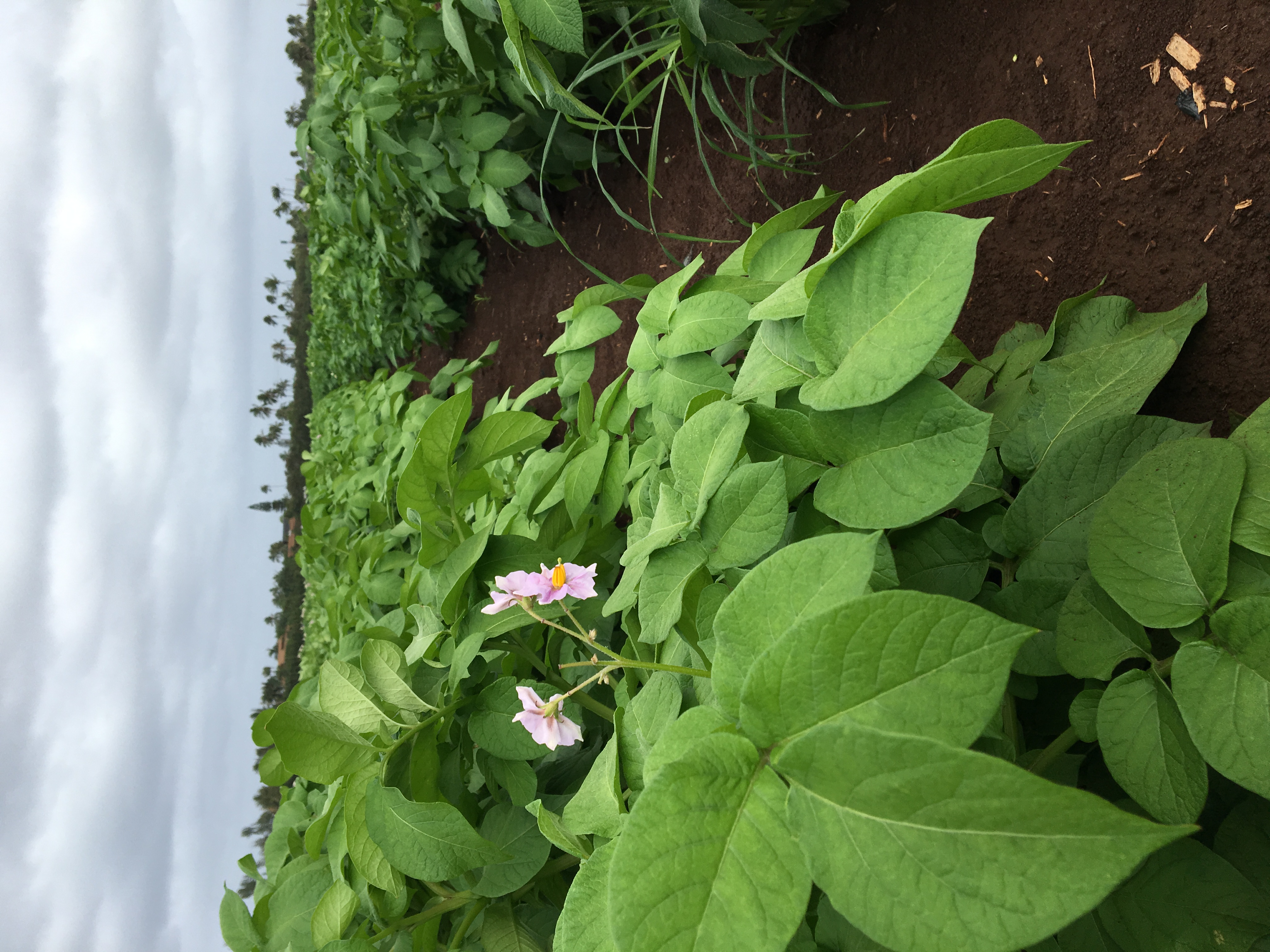
Washington State certified seed potato post-harvest grow-out test in Hawaii. Courtesy Washington State Dept. of Agriculture
A total of 3,526 acres of seed potatoes were entered for certification during the 2020 growing season in Washington State. This is a 44-acre decrease from 2019.
The top four varieties grown are:
-
Ciklamen: 511 acres
-
Chieftain: 341 acres
-
Russet Burbank: 263 acres
-
907-15: 245 acres
The total acres planted include 135 different potato varieties ranging in size from partial-acre plots to 110-acre fields. Most seed lots are less than 20 acres in size and include numbered clones, table stock, processing and heirloom variety potatoes. This year saw 465 individual seed lots from eight separate farms entered for certification.
Washington’s climate provided ideal growing conditions this season. Washington State Department of Agriculture (WSDA) staff noted that late blight and blackleg disease pressure was slight to nonexistent.
Harvest began the second week of September with dry weather. Harvest was completed in late October. Washington saw above-average yields with generally good quality, size and condition of seed lots going into storage. Seed shipments to southern climates began in late fall and continued into the winter months, with the majority of seed set to be shipped in early spring.
As of this writing, Washington State certified seed growers were in the process of submitting seed lot samples for the post-harvest test.
Manitoba
Seed Potato Growers Association of Manitoba
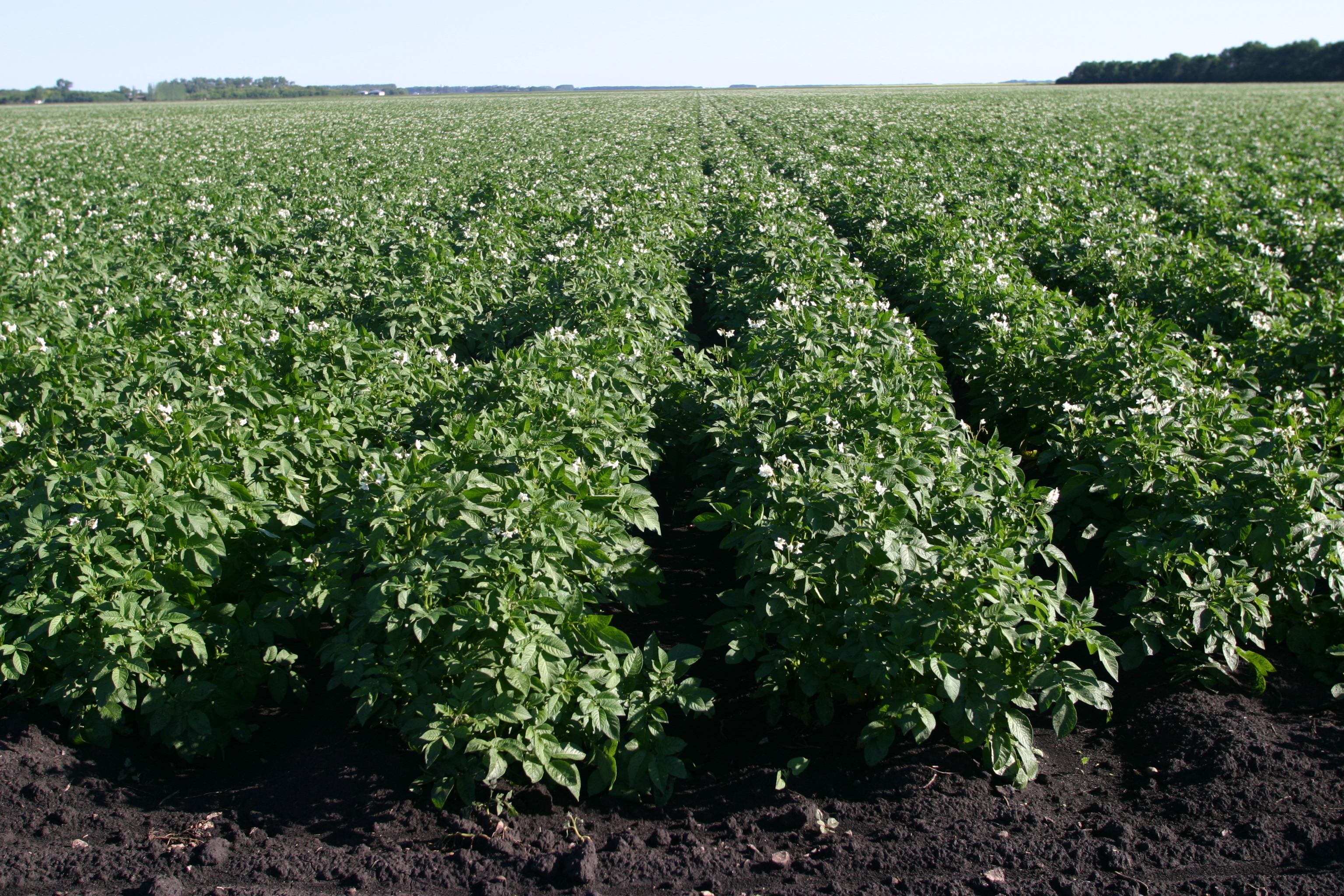
Seed potato fields in Manitoba
The 2020 growing season in Manitoba was one of above-normal temperatures and below-normal rainfall. Despite the weather, seed potato yields were average with good quality. The harvest season had very nice weather: little rain with temperatures that were neither too hot nor too cold. There was no reported frost damage to the seed crop.
Manitoba’s seed is grown by 10 experienced growers. These growers grow in excess of 45 varieties on close to 6,000 acres of land. Varieties include specialty, table, chip and fry processing varieties. Most acres are planted to varieties to accommodate the three french fry processing facilities located in the province. The bulk of the seed acres are grown under irrigation with almost all of the fry processing varieties grown under pivots.
Russet Burbank, once again, was the No. 1 variety in terms of acres planted and harvested in 2020. Manitoba seed is exported and sold inter-provincially, but the bulk of the crop stays in Manitoba to support an expanding commercial potato industry.
The 2020 seed crop was grown under relatively low disease pressure. The incidence of foliar diseases was less than normal; for several years in a row, there has been no late blight reported in the province. Manitoba’s reputation of having harsh winters does come along with some benefits. Aphids are not able to overwinter, which usually results in low aphid numbers throughout the season. Regardless, growers diligently protect their seed against the viruses aphids carry, primarily with the use of aphid oils and aphicides. As a result, seed grown in Manitoba can be expected to have low virus numbers year in and year out.
For a complete listing of varieties and generations available, refer to the Manitoba Seed Potato Directory at www.manitobaseedpotatoes.com.